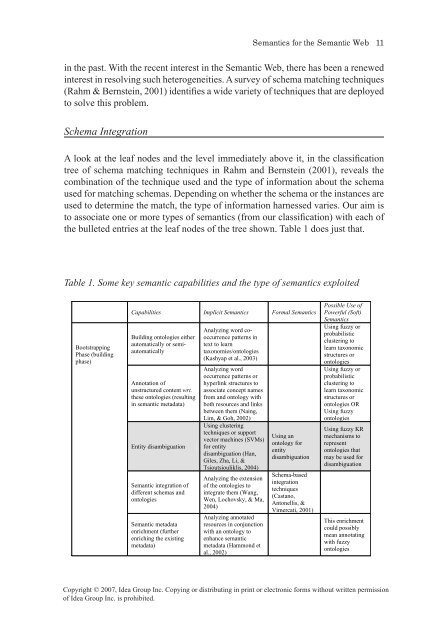Semantic Web-Based Information Systems: State-of-the-Art ...
Semantic Web-Based Information Systems: State-of-the-Art ...
Semantic Web-Based Information Systems: State-of-the-Art ...
Create successful ePaper yourself
Turn your PDF publications into a flip-book with our unique Google optimized e-Paper software.
Semant cs for <strong>the</strong> Semant c <strong>Web</strong><br />
in <strong>the</strong> past. With <strong>the</strong> recent interest in <strong>the</strong> <strong>Semantic</strong> <strong>Web</strong>, <strong>the</strong>re has been a renewed<br />
interest in resolving such heterogeneities. A survey <strong>of</strong> schema matching techniques<br />
(Rahm & Bernstein, 2001) identifies a wide variety <strong>of</strong> techniques that are deployed<br />
to solve this problem.<br />
Schema Integration<br />
A look at <strong>the</strong> leaf nodes and <strong>the</strong> level immediately above it, in <strong>the</strong> classification<br />
tree <strong>of</strong> schema matching techniques in Rahm and Bernstein (2001), reveals <strong>the</strong><br />
combination <strong>of</strong> <strong>the</strong> technique used and <strong>the</strong> type <strong>of</strong> information about <strong>the</strong> schema<br />
used for matching schemas. Depending on whe<strong>the</strong>r <strong>the</strong> schema or <strong>the</strong> instances are<br />
used to determine <strong>the</strong> match, <strong>the</strong> type <strong>of</strong> information harnessed varies. Our aim is<br />
to associate one or more types <strong>of</strong> semantics (from our classification) with each <strong>of</strong><br />
<strong>the</strong> bulleted entries at <strong>the</strong> leaf nodes <strong>of</strong> <strong>the</strong> tree shown. Table 1 does just that.<br />
Table 1. Some key semantic capabilities and <strong>the</strong> type <strong>of</strong> semantics exploited<br />
Bootstrapping<br />
Phase (building<br />
phase)<br />
Capabilities Implicit <strong>Semantic</strong>s Formal <strong>Semantic</strong>s<br />
Building ontologies ei<strong>the</strong>r<br />
automatically or semiautomatically<br />
Annotation <strong>of</strong><br />
unstructured content wrt.<br />
<strong>the</strong>se ontologies (resulting<br />
in semantic metadata)<br />
Entity disambiguation<br />
<strong>Semantic</strong> integration <strong>of</strong><br />
different schemas and<br />
ontologies<br />
<strong>Semantic</strong> metadata<br />
enrichment (fur<strong>the</strong>r<br />
enriching <strong>the</strong> existing<br />
metadata)<br />
Analyzing word cooccurrence<br />
patterns in<br />
text to learn<br />
taxonomies/ontologies<br />
(Kashyap et al., 2003)<br />
Analyzing word<br />
occurrence patterns or<br />
hyperlink structures to<br />
associate concept names<br />
from and ontology with<br />
both resources and links<br />
between <strong>the</strong>m (Naing,<br />
Lim, & Goh, 2002)<br />
Using clustering<br />
techniques or support<br />
vector machines (SVMs)<br />
for entity<br />
disambiguation (Han,<br />
Giles, Zha, Li, &<br />
Tsioutsiouliklis, 2004)<br />
Analyzing <strong>the</strong> extension<br />
<strong>of</strong> <strong>the</strong> ontologies to<br />
integrate <strong>the</strong>m (Wang,<br />
Wen, Lochovsky, & Ma,<br />
2004)<br />
Analyzing annotated<br />
resources in conjunction<br />
with an ontology to<br />
enhance semantic<br />
metadata (Hammond et<br />
al., 2002)<br />
Using an<br />
ontology for<br />
entity<br />
disambiguation<br />
Schema-based<br />
integration<br />
techniques<br />
(Castano,<br />
Antonellis, &<br />
Vimercati, 2001)<br />
Possible Use <strong>of</strong><br />
Powerful (S<strong>of</strong>t)<br />
<strong>Semantic</strong>s<br />
Using fuzzy or<br />
probabilistic<br />
clustering to<br />
learn taxonomic<br />
structures or<br />
ontologies<br />
Using fuzzy or<br />
probabilistic<br />
clustering to<br />
learn taxonomic<br />
structures or<br />
ontologies OR<br />
Using fuzzy<br />
ontologies<br />
Using fuzzy KR<br />
mechanisms to<br />
represent<br />
ontologies that<br />
may be used for<br />
disambiguation<br />
This enrichment<br />
could possibly<br />
mean annotating<br />
with fuzzy<br />
ontologies<br />
Copyright © 2007, Idea Group Inc. Copying or distributing in print or electronic forms without written permission<br />
<strong>of</strong> Idea Group Inc. is prohibited.


